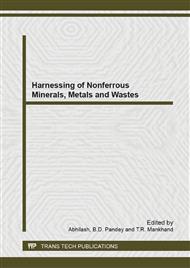p.21
p.33
p.45
p.55
p.65
p.73
p.81
p.93
p.117
Electro-Crystallization of Antimony from Acidic and Alkaline Baths in Diaphragm-Less Cell
Abstract:
Studies based on electrocrystallization of antimony were carried out to evaluate the effects of current density and antimony concentration in the electrolytic bath on cathodic current efficiency, energy consumption, and quality of the deposits during electrowinning of antimony from Sb2O3-HCl and Sb2S3-NaOH systems. In acidic bath, current efficiency for electrodeposition of antimony increases with the increase in current density till 150 A/m2, beyond which it follows a trend of gradual diminution. On varying antimony concentration in the bath, current efficiency was found to improve significantly and the optimum antimony concentration in Sb2O3-HCl system was evaluated to be about 60 g/L. In alkaline bath, current efficiency was observed to be maximum at 50 A/m2 and further, with the increase in current density it progressively decreases. However, energy consumption for electrowinning of antimony in both of the baths gradually increases with the increase in current density. At a current density less than 150 A/m2, alkaline bath was found to be more current efficient in comparison to the acidic bath. Crystallographic studies by XRD, imaging by optical microscopic technique and morphological studies by SEM were also carried out to differentiate antimony deposits obtained from acidic and alkaline baths.
Info:
Periodical:
Pages:
65-72
Citation:
Online since:
November 2013
Keywords:
Price:
Сopyright:
© 2014 Trans Tech Publications Ltd. All Rights Reserved
Share:
Citation:


